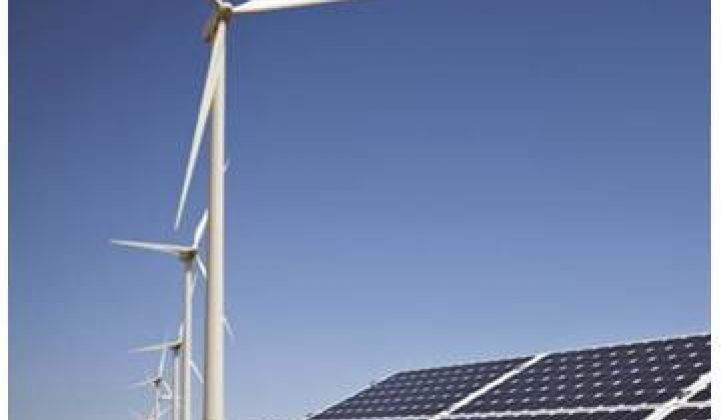Though Element Power did not set out to co-locate wind and solar, harvesting solar at a site adjacent to its Macho Springs Wind project in New Mexico became an opportunity it couldn’t resist.
“This was not envisioned as a wind/solar play, but rather as two distinct projects, one wind and one solar, that were developed separately,” said Element Power Chief Operating Officer Raimund Grube.
While developing wind at Macho Springs, Element Power saw that the sun is just as exploitable at the Luna County site in New Mexico’s southwestern corner. The 50.4-megawatt wind project’s El Paso Electric-owned substation, Element Power realized, provides a ready interconnection to the existing 345-kilovolt transmission system for an adjacent solar project.
“It’s not the co-location, per se,” Grube said. “The substation was built for the wind project [and] that is part of the expense of any energy project.” But, he explained, “there are some economies of scale as you bring on more megawatts into an existing substation.”
“Building the wind farm allowed us to learn from New Mexico and Arizona,” said Element Power Senior Project Manager John Knight. “It opened up new opportunities and got us thinking about how we could further develop the project. We were sitting in a meeting one day and the question just came up -- ‘What about solar?’”
“There is a demand for renewables in that part of the country and it’s a place where both solar and wind can be competitive,” added Grube. “The opportunity, land and resource converged.”
The success of the 2,000-acre wind project, which employed 150 people during construction, Knight said, was important. “Any time you’re developing a project,” he explained, “if you do your job right, phase two, three, and four are going to be a lot easier because you will have gained the support of the local community.”
In building the Macho Springs wind project, composed of 28 Vestas V100 1.8-megawatt turbines, Knight added, “we made sure that everything we said we would do in the community, we did.” The company sourced “as much of the labor force as [it] could locally and sourced materials locally so that we could have a true economic impact.” As a result, Element Power has “the support of local government and the business community.”

“The starting point,” Grube said, “is that there is good solar and good wind, which enables both to be cost-competitive sources of energy for utilities.” But, he added, “relationships that we’ve established in New Mexico and in the local community are instrumental.”
Macho Springs Solar will be a 50-megawatt photovoltaic (PV) installation, Knight said. The specific technology remains undecided. It “is in what we term a late stage of development,” Knight elaborated. “We are finalizing land agreements [and] the final negotiation of an offtake or power purchase agreement (PPA) is pending for the solar project’s output.”
He could not yet say whether the power purchaser is Tucson Electric Power, the Arizona utility taking the wind project’s output, but he did say the PPA deal was “a key” to development. “We hope to break ground by the fourth quarter of this year,” Knight said.
Transmission system operators consistently express concern about managing wind and solar variability but adjacent projects makes the task somewhat simpler, according to enXco Vice President Mark Tholke, who is leading the development of adjacent solar and wind projects in California’s Tehachapi Mountains. “Studies show that wind and solar generate at different times,” he said. “Wind might feed the transmission system 30 percent to 40 percent of the time. When you layer in the solar, that puts more power onto those same lines.”
Combining solar and wind is not uncommon in backyard-sized setups. Where there is no grid service, or to minimize grid reliance, a combination of solar panels and a small wind turbine can maximize local resources.
According to China state news agency Xinhua, North China Grid Co., a subsidiary of State Grid Corp, China's biggest transmission operator, brought a 140-megawatt wind-solar hybrid project, composed of 100 megawatts of wind and 40 megawatts of PV solar, on-line in January. It may be the only large on-line utility-scale solar-wind hybrid project in the world. Described as a “demonstration project” in Hebei Province, it reportedly also incorporates a 20-megawatt battery storage capability.
There are some small utility-scale U.S. hybrid experiments. The most widely known is Western Wind’s “fully integrated” 10.5-megawatt Arizona system composed of five two-megawatt Gamesa turbines and a 500-kilowatt Suntech crystalline PV array. A number of developers have announced plans similar to those of Element Power at Macho Springs to retrofit solar energy systems adjacent to producing wind projects to test grid operators’ capability to integrate the two.
There is nothing in the U.S. on the scale of the enXco Pacific Wind/Catalina Solar undertaking. It will have 70 two-megawatt REPower turbines and will be the biggest Solar Frontier copper indium gallium diselenide (CIGS) PV installation in the world. It will demonstrate, Tholke said, how effective it can be to feed the grid with both resources.
EnXco has already learned things Element Power could benefit from knowing. “It would have,” Tholke noted, “been more efficient if we had figured out the mechanics of how to share the gen-tie earlier.”



